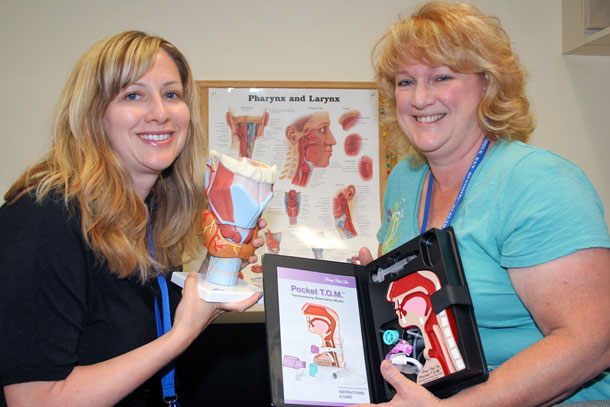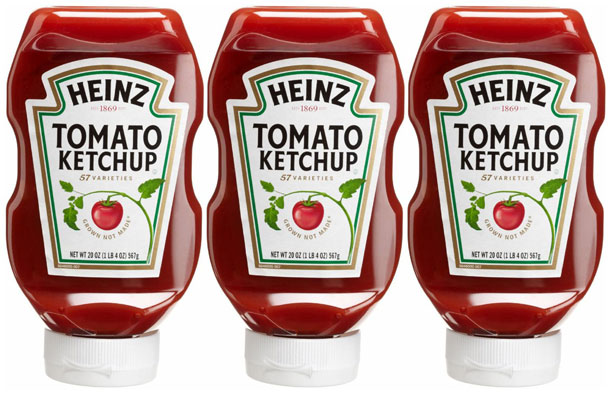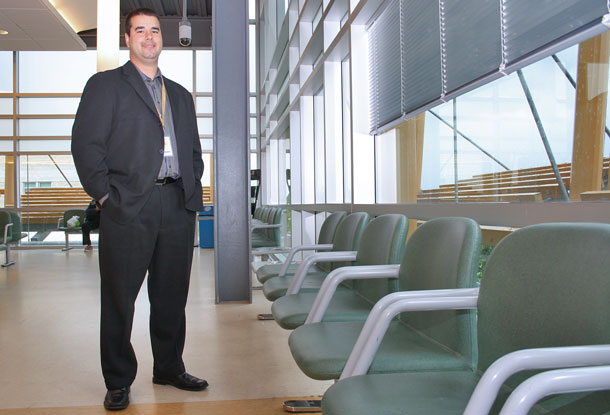

Thunder Bay Regional Health Science Centre Patients Helped by Grant
THUNDER BAY – Inpatients at the Thunder Bay Regional Health Sciences Centre sometimes have difficulties swallowing. These difficulties can be caused by strokes, progressive neurological diseases, acquired brain injuries, cancers, congenital and developmental disorders, and cardiac and respiratory issues.
[sws_pullquote_right]“We can show them the open airway, and show them how it closes over when you swallow. We can also show them what is wrong with their swallowing” [/sws_pullquote_right] Three speech-language pathologists (SLPs), one full-time and two half-time, are available at the Health Sciences Centre to help patients manage these swallowing problems. The anatomy of the swallowing mechanism is complicated and difficult for patients to understand. Thanks to a Family CARE Grant, the team can now use a pair of models to assist with the education for patients and their family members.
“We can show them the open airway, and show them how it closes over when you swallow. We can also show them what is wrong with their swallowing,” said Laurie Ryan-Cooper, one of the SLPs with the program.
One model is a life-size, 3D representation of the parts of the throat with rubberized parts that you can touch, move, and even take apart. The other is a 2D model that shows the airway and the esophagus (the pathway to the stomach). It also illustrates the anatomy of a patient with a tracheostomy (breathing tube) and/or feeding tube through the nose.
The models allow the SLPs to demonstrate to patients and families exactly what is happening in the throat – or what might not be happening – so that they can visualize the risks associated with swallowing difficulties including choking and aspiration (inhaling food and fluid in the lungs).
“Lots of people don’t realize that there is a high rate of swallowing disorders in people who have dementia,” said Allyson McDonald, another SLP with the program. These disorders are part of the neurological decline as certain diseases like Alzheimer’s progress.
The models help patients and caregivers understand why it is important to follow certain strategies (e.g. modify diet textures, sit up while eating or drinking, take smaller bites and sips, eat more slowly) . “It helps patients and their families understand the rationale behind our recommendations,” McDonald said.
So far, the response from patients has been positive.
“They really appreciate the model – it gives them that ‘a-ha’ moment to help them understand what it going on in their throat and how they can reduce risks associated with swallowing difficulties,” Ryan-Cooper said.
The two models were purchased with funding from the Volunteer Association / Thunder Bay Regional Health Sciences Foundation Family CARE Grants. These grants are employee-driven, encouraging staff to identify areas of improvement in their own areas of the Health Sciences Centre and providing up to $2,500 in funding for a solution. After all, who better to recognize these opportunities than the people working directly with patients?
You can help too. Your donation to either the Volunteer Association or the Health Sciences Foundation will help us fund more projects like this one. Find out more on our website at www.healthsciencesfoundation.ca or call us directly at (807) 345-4673.







